Seventy years ago, one of Walt Disney’s most famous dogs took her first steps onto the silver screen…and promptly met a roguish (though dashing) independent mutt. Lady and the Tramp debuted on June 22, 1955 – just a few weeks before the opening of Disneyland – and took the canine world by storm. Directed by Disney Legends Hamilton Luske, Clyde Geronimi, and Wilfred Jackson, Disney’s 15th animated feature film was the highest grossing effort since 1937’s groundbreaking Snow White and the Seven Dwarfs.
Let’s celebrate the time-stamped, yet timeless, tale of puppy love with a brief history and fun facts all about Disney’s Lady and the Tramp.
Lady and…Happy Dan?
Classic animated Disney films tend to be associated with tried-and-true fairy tales and other well known, previously published stories. Lady and the Tramp, however, is not one of those stories. In fact, one can successfully argue that Lady and the Tramp is Disney’s first animated film with an original story – one which began in 1937.
At the Disney Studios, story man (and Disney Legend) Joe Grant approached Walt Disney himself with some sketches he had made of his English springer spaniel named Lady, and an idea he had for a story starring his spaniel and the antics she displayed when she was “shoved aside” for the family’s new baby. Walt encouraged Grant to develop the story, but the boss was never really thrilled with the product, lamenting that Lady was too sweet and there was just not enough meat on the bone for an intriguing story. Grant continued to work on additional ideas over time, but ultimately the story languished and was shelved.
Fast forward about eight years later. Walt happened upon a short story in a 1943 issue of Cosmopolitan magazine titled “Happy Dan the Whistling Dog” (it has also been referred to as “Happy Dan the Cynical Dog”). The story was written by Ward Greene, an editor at King Features – a distributor for Disney comics at the time. Walt was intrigued by the character of Dan – a cynical canine with a reckless, independent, happy-go-lucky attitude. A dog who just might be the perfect foil (and romantic interest) for Grant’s distinguished Lady. Walt reached out to Greene, excitedly stating “Your dog and my dog have got to get together!”
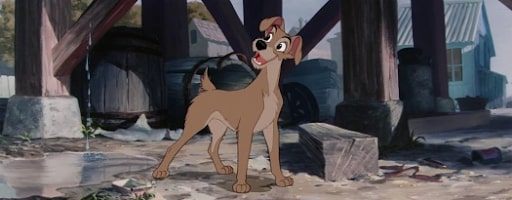
Walt purchased the story rights from Greene, and brought him on board to develop a story and screenplay for a full film. By 1953, the story was fully flushed out, and Walt tasked Greene with writing a novelization for print. Since the story was an original, and not based on a long standing, well known tale, Walt insisted that the novelization be released some two years before the film itself, to give audiences time to get to know the story and characters. The first edition of Lady and the Tramp was published later that year, with Greene credited as the sole writer (Joe Grant had left the Disney Studios in 1949, though some of his ideas and sketches were incorporated into the story).
Puppy Love
Walt celebrated Lady and the Tramp as a fun picture to make, stating “Freedom would be the key word in discussing the advantages of this situation. We were free to develop the story as we saw fit, which is not the case when you work on a classic.” Being an original story, Disney wasn’t compelled to follow any pre-existing storylines, and therefore could be fully creative with the plot and characters. As such, Walt proudly infused a bit of his own romance into the project.

In the film’s unforgettable opening Christmas scene, Darling unwraps a pink striped hat box from Jim Dear and finds Lady inside! The adorable scene was based on an actual moment in Walt’s personal life.
Soon after Walt and his wife Lillian purchased their first home in Los Angeles, Walt wanted to complete his ideal family dynamic with a dog. But Lillian was not so enthused about the idea. Walt was determined, and continued to pepper Lillian with dog breed ideas. Eventually Lillian relented and expressed interest in the Chow Chow breed, deciding that if she had to have a dog, she would be ok with a Chow. Walt struck while the iron was hot, purchasing a Chow puppy almost immediately. But Walt kept the puppy secret, only giving him to Lillian on Christmas Eve in…you guessed it…a fancy hat box.
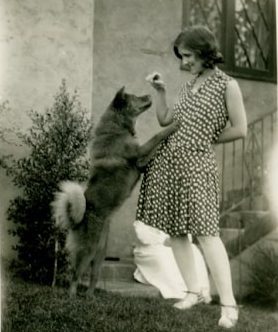
Lillian was instantly smitten with the dog, and the Disneys named him Sunnee. Walt once stated that he “never saw anyone so crazy about an animal.”
Walt Disney’s Small Town America
The setting for Lady and the Tramp – like the setting for Disneyland’s Main Street, U.S.A. – was partly inspired by Walt’s boyhood hometown of Marceline, Missouri. A small New England-style town features a series of colorful and well maintained two-story houses – all of which boast perfectly manicured lawns as they line tree-filled cobblestone streets. Wrought iron and wooden picket fences clearly define every individual property – and display everything Tramp rebukes as a confined society.
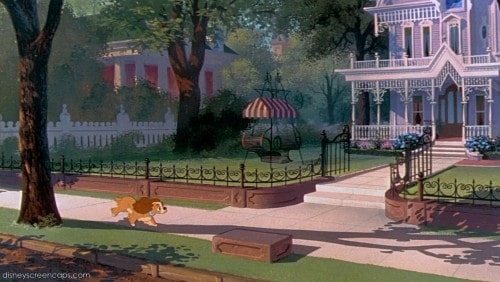
Entering the Darling residence, the inside of the house clearly establishes the time period and the family’s social status, while also presenting a warm and friendly stage on which to tell Lady’s story. According to legendary Disney Imagineer Tony Baxter “What you see in Lady and the Tramp is a beautifully detailed real Victorian world.” Disney animator Andreas Deja added “It’s almost like a Norman Rockwell painting. It has that detail and Americana styling to it.”
The Dog Pound
Lady experienced a rude awakening when she ended up in the dog pound and saw “how the other half lived.” But out of that trip came a deeper appreciation for all walks of canine life.
The single most notable dog in the pound was also the biggest real-world personality performing in the film. Legendary jazz singer Peggy Lee provided the voice for the appropriately-named Peg, a Pekingese who is constantly flirting with life in the pound. The casting of Lee was one of the first instances of Disney casting a superstar in a voice role. In addition to voicing Peg, Lee also provided vocals for Darling, as well as those two pesky cats, Si and Am.
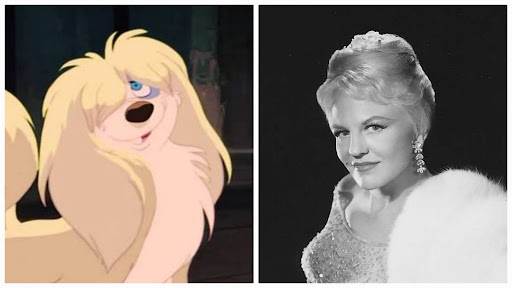
Of course, the real score in casting Peggy Lee was in capturing her musical genius. She wrote six songs for the film (along with Sonny Burke), including the classic “He’s a Tramp,” and she performed most of the songs herself. In addition to “He’s a Tramp,” Lee sang Darling’s part in “La La Lu” and both feline parts in “The Siamese Cat Song” (more commonly known as “We Are Siamese”). Lee’s stardom helped promote the film, as she appeared on a weekly episode of the Disneyland television series titled “Cavalcade of Songs” to talk about her role in the film and sing a few tunes.
Unfortunately, Lee’s relationship with Disney soured in 1988 over a disagreement regarding the rights to transcribed versions of her music on videotape. Lee sued the Walt Disney Company, claiming she was due royalties for her work shown on video tapes – a technology that didn’t exist when she agreed to write and perform for Disney. In 1991, after a lengthy lawsuit, Lee was awarded $2.3 million.
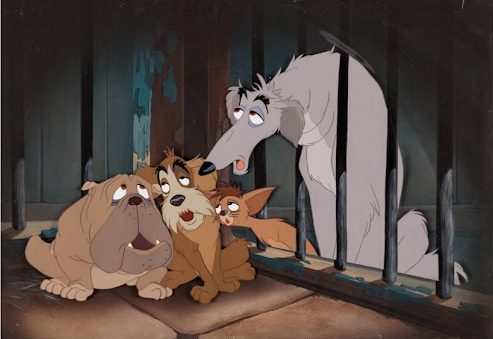
The other dogs in the pound performed as a group effort. That heartache of a song howled by the jailbird dogs in the pound is titled “Home Sweet Home” and was performed by The Mellomen Quartet (which includes Disney Legend Thurl Ravenscroft).
Outside the Pound
Of course, two of the most popular dogs in the film never even visited the pound. Jock – a Scottish terrier, and Trusty – a bloodhound, are two oddly coupled peas in a pod, and were Lady’s loyal neighborhood friends from day one.
What color would you use to describe Jock? If you said black, you’d technically be wrong. While Jock is meant to look black, Disney animators used a darker shade of gray for the terrier, countered with black detailing for his facial expressions. Animators then cleverly placed him within brighter backgrounds, to give him the illusion of being black.
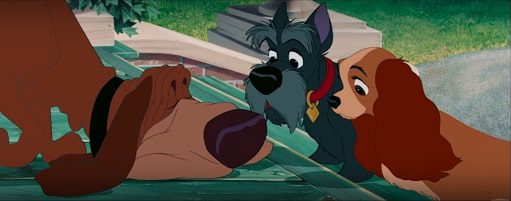
As for Trusty – his diligent nose (inspired by his grandpappy “Old Reliable”) got him in serious trouble near the end of the film. In the film’s climax, Trusty gets hit by the dog catcher’s wagon and lies motionless. When Jock nudges Trusty and he does not move, Jock lets out a horrific howl of an animal in mourning. Originally, Trusty was scripted to die in this scene, hence Jock’s heartbreaking reaction. But realizing the scene was too traumatic for young audiences (thanks in part to Peggy Lee’s terribly upset reaction when seeing the drafted scene), Walt decided to let Trusty off the hook with an injury.
Fun Fact: Jock makes a cameo appearance in 1961’s One Hundred and One Dalmatians as one of the dogs in the film’s “Twilight Bark” sequence. Jock, Trusty, and Peg all appear together in 1988’s Oliver & Company during the musical number “Why Should I Worry?”
In CinemaScope (Sort of)
In the days of yore, the standard movie screen ratio, dubbed the “Academy ratio”, was 4:3, which is equivalent to 1.37:1. This size dominated film formats until the mid-1950s. But in 1953, 20th Century Fox introduced CinemaScope – a wider lens capturing a 2.55:1 ratio. CinemaScope ushered in the era of widescreen films, which have been a mainstay in the film industry ever since, though the specific CinemaScope process was discontinued in 1967.
Lady and the Tramp was the first animated Disney feature to use CinemaScope. With the wider screen, the characters were free to roam through the Darling house, trot through the upscale neighborhood, and even explore sections of the quaint American downtown – without depending exclusively on moving backgrounds set behind stationary characters.
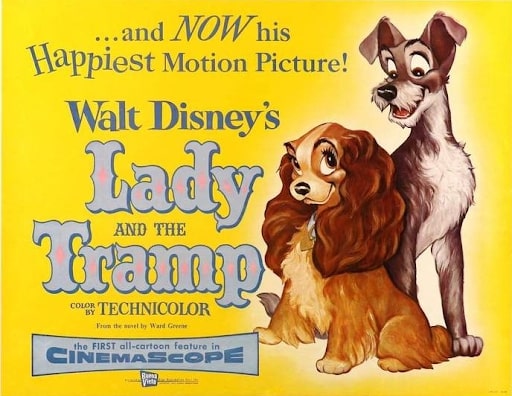
Unfortunately for Disney, many theaters of the day did not have the equipment to show films in widescreen CinemaScope. Walt instructed his studio to produce two versions of the film: one for CinemaScope, and one where the background and characters were readjusted for the traditional Academy ratio screen. This decision was typical for Walt’s tried-and-true practice of keeping one foot in the past, and the other in the future.
Dog’s Eye View
Lady and the Tramp is very much a time-stamped film in Disney’s storied history. The film was released to theaters less than a month before Disneyland opened. With Walt being intimately involved in the design of Disneyland, his thoughts and insights bled over to the design of Lady and the Tramp. We already explored how the small town setting of the film closely mirrors the turn-of-the-century design of Disneyland’s Main Street U.S.A.
Another connection between the film and Disneyland lies in their unique viewpoints. While supervising the design of Disneyland’s Main Street, Walt insisted that the sightlines of the storefronts and other entertainment elements be accessible to kids, via lower reaching windows and the careful placement of decor. In doing his assessment, Walt would kneel down to the height of a child to evaluate the design before construction. If it looked appealing to Walt from down there, then a child would be similarly impressed. Walt trained his designers to adopt the same care, and the result is a Main Street that is accessible to guests of all heights – especially children.

While animating Lady and the Tramp, Walt’s artists adopted a “dog’s eye view” of storytelling. Much of the animation (especially indoor and close-up scenes) were drawn from a dog’s perspective. The background artists made miniature models of the interiors of the Darlings’ home and took photos from deliberately low angles to simulate a dog’s eye view of their world. Adding depth to the low-lying homeworld of a dog, Darling and Jim Dear’s faces are rarely seen, keeping the action closer to ground level.
We Are Siamese (If You Please)
Most animated films in the Disney catalog have clear cut villains challenging the heroes. Lady and the Tramp diverges from most other Disney films here, having no traditional primary villain. The closest the film comes to having a traditional villain is Aunt Sarah – an intolerant woman with no use for dogs – and her pesky Siamese cats she brings with her to house-sit while Darling and Jim Dear are away for the weekend. These cats – Si and Am – aren’t overtly evil, but more mischievous in the way they tease Lady and manipulate Aunt Sarah into blaming Lady for their own antagonistic actions.
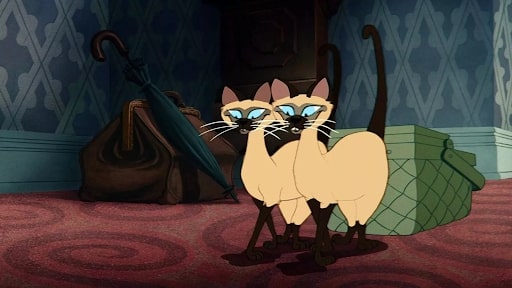
With their names combined – Si and Am, or “Siam,” is the former name of the Kingdom of Thailand, referencing the cats’ Eastern civilization heritage. In recent years, Si and Am have been cited as Asian stereotypes because of their exaggerated accents, yellow fur, almond-shaped eyes, and bucked teeth. As of the publishing of this article, the original version of the film still airs on Disney+, but it carries a disclaimer warning of potentially offensive content.
Fun Fact: Si and Am were once named Nip and Tuck in earlier story versions.
What’s in a Name?
The etymology of character names in Disney films always yields fascinating tidbits, and Lady and the Tramp is no exception.
Starting with the title characters, let’s dive into Lady. The cocker spaniel’s elegant name is a direct copy/paste from storyman Joe Grant’s English springer spaniel of the same name. But Lady’s nicknames carry a bit more interest. In the film, Tramp never calls Lady by her actual name. Instead, he calls her by two nicknames: “Pigeon” (or “Pidge” for short), and “Kid.” Tramp uses “Pidge” as a term of endearment, owing to Lady’s naivety (much like that of a pigeon, I suppose?) as part of what he calls the “leash and collar set.” The lazy but affable term “Kid” is used by Tramp as means of being friendly while keeping a defensive distance to avoid using a name and getting too close emotionally.
As for Tramp – he received his name from the big man himself – Walt Disney. The cynical dog had various names during development, including Homer, Rags, and Bozo, before Walt chose Tramp. Walt received strong objections from the film distributors regarding Tramp’s name, as they felt the title Lady and the Tramp was a little too “adult” sounding for a Disney film product. But Walt stood his ground, and the rest is doggone history.
Bella Not?
Let’s end our celebration with a fun fact about the most iconic scene from the film (or any Disney film for that matter) – the famous “spaghetti scene.” The film’s most romantic moment occurs when Lady and Tramp share a meal at one of Tramp’s favorite eateries – Tony’s.
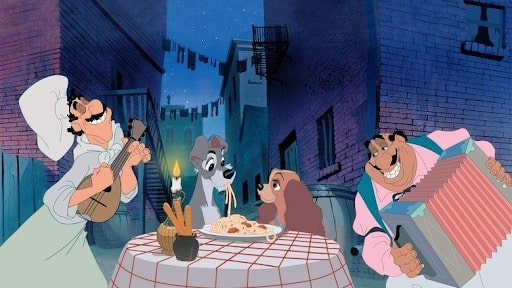
Believe it or not, Walt wanted to cut the scene from the film before it was even animated, feeling that the idea was awkward. Animator Frank Thomas experimented in his backyard with his own dogs eating spaghetti, and came up with some sketches that finally won Walt over. The scene made the final cut and became the most memorable scene in the film. The famous “spaghetti scene” has been ranked among the great romantic sequences (and most parodied moments) in cinematic history.
In 2023, Lady and the Tramp received one of the ultimate film honors when it was selected for preservation in the National Film Registry by the Library of Congress deeming it “culturally, historically or aesthetically significant.” In my personal opinion, this iconic film boasts all three of those tributes, making it a perfect fit among film royalty.
Thanks for reading all about Walt Disney’s charming canine classic. Where does Lady (or any of the other pooches in the film) rank on your list of Disney’s top dogs? Let me know what you think by joining the conversation on social: Instagram Facebook X
Sources:
Lady’s Pedigree: The Making of Lady and the Tramp – Special Feature in the 50th Anniversary DVD of Lady and the Tramp.
Walt’s Valentine – Natalie Hollett, Walt Disney Family Museum blog, February 14, 2014
The Story of Lady and the Tramp, Part One, Jim Korkis, October 9, 2013
The Story of Lady and the Tramp, Part Two, Jim Korkis, October 16, 2013
Walt Disney: An American Original – Bob Thomas, 1976




